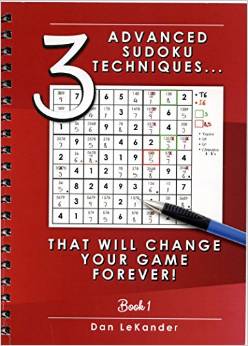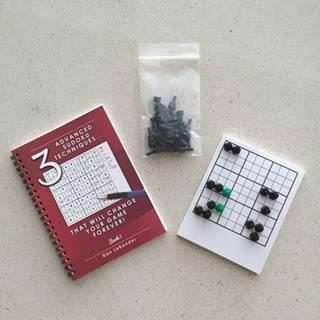Sudoku mistakes! We all make them. The other day I was about 80% complete on a difficult puzzle. I paused, looked at the puzzle, and saw two 6’s in row 7. What! How did that happen? You just have to laugh at yourself.
What I find is that you must be 100% engaged when you are doing a puzzle. There is no room for distractions or being in a hurry. So, treat yourself to uninterrupted Sudoku experiences whenever you are solving Sudoku puzzles!
In keeping with the tradition of tackling difficult puzzles, Puzzle #50 is no exception. You may learn the most when you tackle it yourself before looking at my solution!

DAN’S 8-STEP APPROACH TO SOLVING ALL SUDOKU PUZZLES
Once you have completed the puzzle, to the extent that you have filled-in all obvious answers and have written all potential options across the top of the unsolved cells (PUZZLE PREPARATION), Dan recommends the following Steps to complete the puzzle.
Step 1: Sudoku Pairs, Triplets and Quads – September 2015
Step 2: Turbos & Interaction – October 2015
Step 3: Sudoku Gordonian Rectangles and Polygons – November 2015
Step 4: XY-Wings & XYZ Wings – December 2015
Step 5: X-Wings – January 2016
________________
Step 6: DAN’S YES/NO CHALLENGE
Step 7: DAN’S CLOSE RELATIONSHIP CHALLENGE
Step 8: AN EXPANSION OF STEP 7
Steps 1-5 are relatively common techniques and are explained in the TI LIFE articles above. Steps 6-8 are covered in detail, in Dan’s book.
Also, see Sudoku Puzzle Challenge… February 2016, March 2016, April 2016, May 2016, June 2016, July 2016, August 2016, September 2016, October 2016, November 2016, December 2016, January 2017, February 2017, March 2017 , April 2017, May 2017, June 2017, July 2017, August 2017, September 2017, October 2017 , November 2017 , December 2017, January 2018, February 2018, March 2018, April 2018. May 2018, June 2018, July 2018, August 2018, September 2018 , October 2018, November 2018, December 2018, January 2019 and February 2019.
As a reminder, the basic rules of Sudoku are that the numbers 1-9 must be contained and cannot be repeated in a row, column, or box, and there can only be one solution to the puzzle.

PUZZLE PREPARATION
Prior to utilizing techniques first complete the 4 Steps of Puzzle Preparation …
- FILL IN OBVIOUS ANSWERS
- FILL IN NOT-SO-OBVIOUS ANSWERS
- MARK UNSOLVED CELLS WITH OPTIONS THAT CANNOT EXIST IN THOSE CELLS
- FILL IN THE OPTIONS FOR THE UNSOLVED CELLS
OBVIOUS ANSWERS …
Start with the 1’s to see if there are any obvious 1-choice answers. Then navigate the 2’s through 9’s.
The first obvious answer is C6R9 (cell in column 6, row 9) = 8. C4R8=6. Now your grid should look like Example 50.1 below:

NOT-SO-OBVIOUS ANSWERS … there are none.
MARK UNSOLVED CELLS WITH OPTIONS THAT CANNOT EXIST IN THOSE CELLS …
Well, this is sort of the place to do this. Please note that in box 4 (LH middle box of 9 x 9 cells) that there are only two cells that can contain the options 7 & 8. So, we will just jump the gun and enter those two options for C1R6 & C3R6. That concludes this step, as there is nothing else to annotate.
Now your grid should look like Example #50.2 below:

FILL IN THE OPTIONS FOR THE UNSOLVED CELLS …
Remember, we are about to create an obvious triplet in C5R7, C5R8 & C5R9 of 479. So, a 4, 7 and 9 cannot exist in any other cell in column 5. Also, remember that we determined that C1R6 & C3R6 have options 78, an obvious pair. No other cells in row 6 can have the options 7 & 8. Once you fill in the options for the unsolved cells, your grid should look like Example #50.3 below:

STEPS 1-8
We search all rows, columns & boxes in Step 1 for Pairs, Triplets & Quads. In column 8 only 2 unsolved cells contain the 2 options 1 & 3, a hidden pair. We change the options for those cells to 13. Now your grid should look like Example # 50.4 below:

There are no additional Step 1-5 clues.
We will now move to Step 6: Dan’s Yes-No Challenge.
There are 3 circumstances that establish the potential for a Step 6 exercise:
- Look for just 2 unsolved cells in a box that contain the same option where these 2 cells are not in the same row or column.
- Look for just 2 unsolved cells in a column that contain the same option where these 2 cells are not in the same box.
- Look for just 2 unsolved cells in a row that contain the same option where these 2 cells are not in the same box.
We will start by searching the 1’s to see if there is a potential Step 6 clue, and then navigate through the 2-9’s.

Do you agree that one of these two yellow cells in column 2 must be a 1? We will consider them as “driver cells” which “drive” the exercise.
Here is the logic. We will perform two exercises. First, we will assume C2R1 is the 1 and see which other cells cannot be a 1. Then we will assume C2R9 is the 1 and see which other cells cannot be a 1.

We will start by assuming C2R1=1. Then, as marked above, C3R1, C3R2, C5R1 & C6R1 are not a 1 (marked with a “N”). Now the only cell in box 2 that can be a 1 is C6R2, so we will mark it as a “Y”. Then, C6R5=N. C6R6=N. C5R6=Y. C7R6=N. C8R5=Y. C8R9=N.
Now we will assume C2R9=1 (y for yes). Then, C3R8=n. C3R9=n. C7R9=n. C8R9=n. C7R8=y. C7R6=n. C8R5=y. C6R5=n.
We now see in Example #50.6 above that …
· 3 cells have an N,n designation, meaning that they cannot be a 1 regardless of which driver cell is a 1. Therefore, you can remove a 1 as an option from those cells.
· 1 cell has a Y,y designation, meaning it is a 1 regardless of which driver cell is a 1. You may make C8R5=1.
Now your grid should look like Example #50.7 below:

You can see in Example #50.7 above that C8R5=1 and C8R9=3. It then follows that C1R8=3. C2R3=3. C5R3=2. C5R4=5. C5R1=1. C5R6=3. C3R2=1. C6R6=1. C9R5=3. C4R2=3. The puzzle is easily solved from this point, giving you Example #50.8 below:

Again, we very quickly found the weak link in the puzzle at the very beginning of Step 6, which were the 1’s and 3’s. The solution this month was attained by just one Step 6 exercise!
May the gentle winds of Sudoku be at your back,
Dan LeKander
Editor’s note:
In January 2016, we published a final article in his series – but many of us enjoy using “Dan’s Steps,” so when he asked if we would like a puzzle to solve every month … this editor said an enthusiastic… Yes, please! Now we are several years later and on Puzzle #50! Yes, 50!
I suggest you purchase Dan’s book as a Christmas gift: “3 Advanced Sudoku Techniques, That Will Change Your Game Forever!”

The book is available online, amazon.com and on ebay.com.
Most importantly, I ask that you leave comments on any part of his series and throughout the year. Remember when your teacher said – no such thing as a silly question – as we can all learn together.
As always, I want to thank Dan…and his proofreader… Peggy! I am hoping you will enjoy our Sudoku and at the same time join me in thanking Dan - Bravo to you both…
Posted in: Volume 14, Issue 3, March 2019, Sports
Please click here if you are unable to post your comment.
